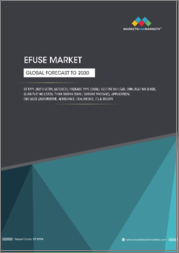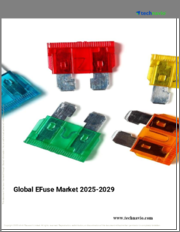
|
시장보고서
상품코드
1766108
세계의 전자퓨즈(eFuse) 시장 예측 - 유형별, 전압 범위별, 패키지 유형별, 용도별, 최종 사용자별, 지역별 분석(-2032년)eFuse Market Forecasts to 2032 - Global Analysis By Type (Discrete eFuses, Multichannel eFuses, Integrated eFuses (IC-based), Auto-Retry eFuses, Latched eFuses, and Other Types), Voltage Range, Packaging Type, Application, End User and By Geography |
||||||
Stratistics MRC에 따르면 전자퓨즈(eFuse) 세계 시장은 2025년에 8억 2,359만 달러, 2032년에는 14억 4,850만 달러에 이를 것으로 예측되며, 예측 기간 중 CAGR은 8.4%를 나타낼 전망입니다. 전자퓨즈(eFuse)는 전자 시스템을 과전류, 과전압, 단락 및 열 결함으로부터 보호하기 위해 사용되는 프로그래머블 회로 보호 장치입니다. 기존 퓨즈와 달리 전자퓨즈(eFuse)는 리셋 가능하고 집적 회로에 의한 정밀한 제어가 가능합니다.
미국 상무부의 최근 통계에 따르면 반도체 산업은 2030년까지 1조 달러에 이를 것으로 예측되고 있으며 전자퓨즈(eFuse)와 같은 부품의 중요성이 부각되고 있습니다.
USB Type-C 및 USB 파워 딜리버리 이용 확대
USB 파워 딜리버리(PD) 규격은 정확한 전류와 전압의 조정을 필요로 하기 때문에 전자퓨즈(eFuse)는 안전성과 성능에 필수적입니다. 소비자들이 고속 충전 및 범용 전원 연결로 전환함에 따라 제조업체들은 스마트폰, 노트북, 주변기기에 USB PD를 통합하고 있습니다. 전자퓨즈(eFuse)는 이러한 용도에서 과전류, 단락, 과열로부터 보호하는 데 중요한 역할을 하고 있습니다.
통합의 복잡성
전통적인 보호 구성 요소를 솔리드 스테이트 솔루션으로 대체하려면 복잡한 설계 전문 지식이 필요합니다. 인터페이스 문제, 호환성 문제 및 열 관리 문제로 인해 채택이 더욱 지연될 수 있습니다. 다양한 전압과 전류 범위에 대한 사용자 정의 요구 사항은 개발 시간과 비용을 증가시킵니다.
전자 시스템의 전력 밀도 증가
전자기기의 소형화와 고성능화의 동향은 효율적인 회로 보호 솔루션에 대한 강한 수요를 낳고 있습니다. 시간을 제공하는 것이 어려워지고 있습니다. 전자퓨즈(eFuse)를 사용하면 설계자는 첨단 전자 시스템의 까다로운 공간, 성능 및 안전 요구 사항을 충족시킬 수 있습니다.
대체 기술의 가용성
PTC 서미스터와 온도 퓨즈와 같은 기존의 보호 부품이 존재하는 것은 전자퓨즈(eFuse)에게 강한 경쟁 압박입니다. 이러한 레거시 구성 요소는 많은 기본 애플리케이션에서 잘 이해되고 널리 사용 가능하며 비용 효율적입니다. 전자퓨즈(eFuse)는 더 많은 기능을 제공하지만 모든 시스템이 프로그래머블 보호를 필요로 하는 것은 아니므로 보다 저렴한 옵션을 제공할 수 있습니다. 게다가 보호 기능을 내장한 새로운 스마트 파워 IC가 대체품으로 등장하고 있습니다. 이러한 대안은 일부 통합 설계에서 이산 전자퓨즈(eFuse)의 필요성을 줄입니다. 시장이 성숙함에 따라 이러한 경쟁은 예산을 중시하는 부문에서 전자퓨즈(eFuse) 채용을 억제할 수 있습니다.
COVID-19의 영향
COVID-19 팬데믹은 당초 락다운과 제조 정지로 전자퓨즈(eFuse)를 포함한 전자 부품공급망을 혼란시켰습니다. 그러나 원격 근무과 디지털 변환이 가속화됨에 따라 가전 및 데이터 인프라에 대한 수요가 급증했습니다. 이러한 변화로 인해 전자퓨즈(eFuse)를 포함한 강력한 전원 보호 솔루션에 대한 관심이 다시 증가했습니다. 제조업체 각 사는 생산을 증강해, 공급 체인의 회복력을 강화하는 것으로 대응했습니다. 유행 후에는 안정적이고 에너지 효율적인 전자 기기에 대한 수요가 계속 증가하고 전자퓨즈(eFuse) 시장의 회복과 성장을 지원합니다.
예측 기간 동안 이산 전자퓨즈(eFuse) 부문이 최대가 될 전망
이산 전자퓨즈(eFuse) 부문은 비용 효율성과 통합의 용이성으로 인해 예측 기간 동안 가장 큰 시장 점유율을 차지할 것으로 예측됩니다. 전자퓨즈(eFuse)는 대폭적인 설계 변경이 필요 없으며 유연한 구현이 가능하기 때문에 대중 시장을 위한 제품으로 매력적입니다.
예측 기간 동안 데이터센터 및 서버 부문의 CAGR이 가장 높을 것으로 예측됩니다.
예측 기간 동안 디지털화와 클라우드 서비스의 확장으로 데이터센터 및 서버 부문이 가장 높은 성장률을 보일 것으로 예측됩니다.
가장 점유율이 높은 지역
예측기간 동안 아시아태평양은 그 견고한 전자기기 제조 에코시스템으로 최대 시장 점유율을 차지할 것으로 예측됩니다. B-C 디바이스와 산업용 오토메이션의 보급이 진행되고 있는 것이 시장의 성장을 지지하고 있습니다.
CAGR이 가장 높은 지역
예측기간 동안 데이터센터 인프라, 전기자동차, 스마트 소비자용 전자기기의 진보로 북미가 가장 높은 CAGR을 나타낼 것으로 예측됩니다. 에너지 효율적인 설계와 규제 준수에 대한 이 지역의 강력한 집중은 정밀한 보호 솔루션에 대한 수요를 증가시킵니다. 대형 하이테크 기업이나 자동차 제조업체는 차세대의 전력 공급과 안전 요건을 채우기 위해서 전자퓨즈(eFuse)를 채택하고 있습니다. 또한, 재생에너지와 전화를 지원하는 정부의 시책에 의해 새로운 용도의 길이 태어나고 있습니다.
무료 맞춤형 서비스
이 보고서를 구독하는 고객은 다음 무료 맞춤설정 옵션 중 하나를 사용할 수 있습니다.
- 기업 프로파일
- 추가 시장 진출기업의 종합적 프로파일링(3개사까지)
- 주요 기업의 SWOT 분석(3개사까지)
- 지역 세분화
- 고객의 관심에 응한 주요국 시장 추정, 예측, CAGR(주 : 타당성 확인에 따름)
- 경쟁 벤치마킹
- 제품 포트폴리오, 지리적 존재, 전략적 제휴를 통한 주요 기업 벤치마킹
목차
제1장 주요 요약
제2장 서문
- 개요
- 이해관계자
- 조사 범위
- 조사 방법
- 데이터 마이닝
- 데이터 분석
- 데이터 검증
- 조사 접근
- 조사 자료
- 1차 조사 자료
- 2차 조사 자료
- 전제조건
제3장 시장 동향 분석
- 소개
- 성장 촉진요인
- 억제요인
- 기회
- 위협
- 용도 분석
- 최종 사용자 분석
- 신흥 시장
- COVID-19의 영향
제4장 Porter's Five Forces 분석
- 공급기업의 협상력
- 구매자의 협상력
- 대체품의 위협
- 신규 참가업체의 위협
- 경쟁 기업간 경쟁 관계
제5장 세계의 전자퓨즈(eFuse) 시장 : 유형별
- 소개
- 이산 전자퓨즈(eFuse)
- 멀티 채널 전자퓨즈(eFuse)
- 통합형 전자퓨즈(eFuse)(IC 기반)
- 자동 재시도 전자퓨즈(eFuse)
- 래치 부착 전자퓨즈(eFuse)
- 기타
제6장 세계의 전자퓨즈(eFuse) 시장 : 전압 범위별
- 소개
- 저전압(12V 이하)
- 중전압(12V-24V)
- 고전압(24V 이상)
제7장 세계의 전자퓨즈(eFuse) 시장 : 패키지 유형별
- 소개
- 얇은 수축 스몰 아웃라인 패키지(TSSOP)
- 스몰 아웃라인 노리드(SON)
- 듀얼 플랫 노리드(DFN)
- 쿼드 플랫 노리드(QFN)
- 기타
제8장 세계의 전자퓨즈(eFuse) 시장 : 용도별
- 소개
- 전원 관리
- 시스템 보호
- 서버 및 스토리지 시스템
- 핫 스왑 용도
- 배터리 관리 시스템
- USB 파워 딜리버리
- 하드디스크 드라이브(HDD)
- 기타
제9장 세계의 전자퓨즈(eFuse) 시장 : 최종 사용자별
- 소개
- 소비자용 전자 기기
- 자동차
- 산업
- 통신
- 데이터센터와 서버
- 항공우주 및 방위
- 기타
제10장 세계의 전자퓨즈(eFuse) 시장 : 지역별
- 소개
- 북미
- 미국
- 캐나다
- 멕시코
- 유럽
- 독일
- 영국
- 이탈리아
- 프랑스
- 스페인
- 기타 유럽
- 아시아태평양
- 일본
- 중국
- 인도
- 호주
- 뉴질랜드
- 한국
- 기타 아시아태평양
- 남미
- 아르헨티나
- 브라질
- 칠레
- 기타 남미
- 중동 및 아프리카
- 사우디아라비아
- 아랍에미리트(UAE)
- 카타르
- 남아프리카
- 기타 중동 및 아프리카
제11장 주요 개발
- 계약, 파트너십, 협업, 합작투자
- 인수와 합병
- 신제품 발매
- 사업 확대
- 기타 주요 전략
제12장 기업 프로파일링
- Analog Devices, Inc.
- STMicroelectronics
- Monolithic Power Systems, Inc.(MPS)
- Microchip Technology Inc.
- Qorvo, Inc.
- Littelfuse, Inc.
- Toshiba Electronic Devices & Storage Corporation
- Texas Instruments Incorporated
- Alpha and Omega Semiconductor(AOS)
- Diodes Incorporated
- Vishay Intertechnology, Inc.
- Silergy Corp.
- Infineon Technologies AG
- Semtech Corporation
- Rohm Co., Ltd.
According to Stratistics MRC, the Global eFuse Market is accounted for $823.59 million in 2025 and is expected to reach $1448.50 million by 2032 growing at a CAGR of 8.4% during the forecast period. An eFuse (electronic fuse) is a programmable circuit protection device used to safeguard electronic systems from overcurrent, overvoltage, short circuits, and thermal faults. Unlike traditional fuses, eFuses are resettable and offer precise control through integrated circuitry. They enhance safety, reliability, and system diagnostics in modern electronics, especially in consumer devices, automotive systems, and data centres. eFuses can also support hot-swap functionality and are often used in compact, high-performance applications.
According to recent statistics from the U.S. Department of Commerce, the semiconductor industry is projected to reach $1 trillion by 2030, highlighting the significance of components like efuses.
Market Dynamics:
Driver:
Increased usage of USB Type-C and USB power delivery
USB Power Delivery (PD) standards require precise current and voltage regulation, making eFuses essential for safety and performance. As consumers shift toward fast-charging and universal power connectivity, manufacturers are incorporating USB PD in smartphones, laptops, and peripherals. eFuses play a crucial role in protecting against overcurrent, short-circuits, and overheating in these applications. Additionally, growing use in industrial and automotive USB-C implementations amplifies market potential. This trend is accelerating innovation and investment in eFuse technologies globally.
Restraint:
Complexity in integration
The complexity of replacing traditional protection components with solid-state solutions requires design expertise. Smaller electronics firms often lack the engineering resources to transition seamlessly to eFuse-based designs. Interfacing challenges, compatibility concerns, and thermal management issues can further delay adoption. Customization requirements for varied voltage and current ranges add to development time and cost. Consequently, these integration complexities limit eFuse deployment in cost-sensitive or legacy systems.
Opportunity:
Increased power density in electronic systems
The trend toward miniaturization and high-performance electronics is creating strong demand for efficient circuit protection solutions. eFuses offer compact, fast-responding, and highly configurable protection, ideal for densely packed systems. As power density increases, traditional thermal fuses struggle to provide the necessary precision and response time. eFuses enable designers to meet stringent space, performance, and safety requirements in advanced electronic systems. This evolving need positions eFuses as a key enabler in next-generation power architectures.
Threat:
Availability of alternative technologies
The presence of conventional protection components such as PTC thermistors and thermal fuses presents strong competitive pressure for eFuses. These legacy components are well-understood, widely available, and cost-effective for many basic applications. While eFuses offer more features, not all systems require programmable protection, making cheaper options viable. Additionally, new smart power ICs with built-in protection are emerging as substitutes. These alternatives reduce the need for discrete eFuses in some integrated designs. As the market matures, such competition could constrain eFuse adoption in budget-driven sectors.
Covid-19 Impact
The COVID-19 pandemic initially disrupted the supply chain of electronic components, including eFuses, due to lockdowns and manufacturing shutdowns. However, as remote work and digital transformation accelerated, demand for consumer electronics and data infrastructure surged. This shift drove renewed interest in robust power protection solutions, including eFuses. Manufacturers adapted by ramping up production and enhancing supply chain resilience. Post-pandemic, the demand for reliable and energy-efficient electronics continues to rise, supporting eFuse market recovery and growth.
The discrete eFuses segment is expected to be the largest during the forecast period
The discrete eFuses segment is expected to account for the largest market share during the forecast period, due to their cost-effectiveness and ease of integration. These components are widely used across consumer electronics, automotive, and industrial applications. Discrete eFuses provide flexible implementation without requiring major design changes, making them appealing for mass-market products. As device complexity increases, demand for simple but reliable protection components continues to grow.
The data centres & servers segment is expected to have the highest CAGR during the forecast period
Over the forecast period, the data centres & servers segment is predicted to witness the highest growth rate, due to increasing digitization and cloud service expansion. These systems require highly reliable and efficient circuit protection to ensure uninterrupted operations. eFuses provide fast-acting and precise protection, which is essential for managing power surges and thermal risks in critical infrastructure. Additionally, modular server designs benefit from the compactness and flexibility of eFuses.
Region with largest share:
During the forecast period, the Asia Pacific region is expected to hold the largest market share due to its robust electronics manufacturing ecosystem. Countries like China, South Korea, Japan, and Taiwan are major hubs for consumer electronics, automotive, and industrial systems. The increasing penetration of USB-C devices and industrial automation across the region is supporting market growth. Government initiatives promoting electronics innovation and manufacturing localization are also fuelling adoption of advanced components like eFuses.
Region with highest CAGR:
Over the forecast period, the North America region is anticipated to exhibit the highest CAGR, owing to advancements in data centre infrastructure, electric vehicles, and smart consumer electronics. The region's strong focus on energy-efficient designs and regulatory compliance enhances the demand for precise protection solutions. Leading tech firms and automotive manufacturers are adopting eFuses to meet next-gen power delivery and safety requirements. Additionally, government policies supporting renewable energy and electrification are creating new application avenues.
Key players in the market
Some of the key players profiled in the eFuse Market include Analog Devices, Inc., STMicroelectronics, Monolithic Power Systems, Inc. (MPS), Microchip Technology Inc., Qorvo, Inc., Littelfuse, Inc., Toshiba Electronic Devices & Storage Corporation, Texas Instruments Incorporated, Alpha and Omega Semiconductor (AOS), Diodes Incorporated, Vishay Intertechnology, Inc., Silergy Corp., Infineon Technologies AG, Semtech Corporation, and Rohm Co., Ltd.
Key Developments:
In June 2025, STMicroelectronics introduces a new Human Presence Detection (HPD) technology for laptops, PCs, monitors and accessories, delivering more than 20% power consumption reduction per day in addition to improved security and privacy. ST's proprietary solution combines market-leading FlightSense(TM) Time-of-Flight (ToF) sensors with unique AI.
In October 2024, Analog Devices, Inc. launched a suite of developer-centric offerings that unite cross-device, cross-market hardware, software and services to help customers deliver innovations for the Intelligent Edge with enhanced speed and security. Central to this launch is CodeFusion Studio(TM), a new, comprehensive embedded software development environment based on Microsoft's Visual Studio code.
Types Covered:
- Discrete eFuses
- Multichannel eFuses
- Integrated eFuses (IC-based)
- Auto-Retry eFuses
- Latched eFuses
- Other Types
Voltage Ranges Covered:
- Low Voltage (<12V)
- Medium Voltage (12V-24V)
- High Voltage (>24V)
Packaging Types Covered:
- Thin Shrink Small Outline Package (TSSOP)
- Small Outline No-Lead (SON)
- Dual Flat No-Leads (DFN)
- Quad Flat No-Leads (QFN)
- Other Packaging Types
Applications Covered:
- Power Management
- System Protection
- Server and Storage Systems
- Hot-Swap Applications
- Battery Management Systems
- USB Power Delivery
- Hard Disk Drives (HDDs)
- Other Applications
End Users Covered:
- Consumer Electronics
- Automotive
- Industrial
- Telecommunications
- Data Centers & Servers
- Aerospace & Defence
- Other End Users
Regions Covered:
- North America
- US
- Canada
- Mexico
- Europe
- Germany
- UK
- Italy
- France
- Spain
- Rest of Europe
- Asia Pacific
- Japan
- China
- India
- Australia
- New Zealand
- South Korea
- Rest of Asia Pacific
- South America
- Argentina
- Brazil
- Chile
- Rest of South America
- Middle East & Africa
- Saudi Arabia
- UAE
- Qatar
- South Africa
- Rest of Middle East & Africa
What our report offers:
- Market share assessments for the regional and country-level segments
- Strategic recommendations for the new entrants
- Covers Market data for the years 2024, 2025, 2026, 2028, and 2032
- Market Trends (Drivers, Constraints, Opportunities, Threats, Challenges, Investment Opportunities, and recommendations)
- Strategic recommendations in key business segments based on the market estimations
- Competitive landscaping mapping the key common trends
- Company profiling with detailed strategies, financials, and recent developments
- Supply chain trends mapping the latest technological advancements
Free Customization Offerings:
All the customers of this report will be entitled to receive one of the following free customization options:
- Company Profiling
- Comprehensive profiling of additional market players (up to 3)
- SWOT Analysis of key players (up to 3)
- Regional Segmentation
- Market estimations, Forecasts and CAGR of any prominent country as per the client's interest (Note: Depends on feasibility check)
- Competitive Benchmarking
- Benchmarking of key players based on product portfolio, geographical presence, and strategic alliances
Table of Contents
1 Executive Summary
2 Preface
- 2.1 Abstract
- 2.2 Stake Holders
- 2.3 Research Scope
- 2.4 Research Methodology
- 2.4.1 Data Mining
- 2.4.2 Data Analysis
- 2.4.3 Data Validation
- 2.4.4 Research Approach
- 2.5 Research Sources
- 2.5.1 Primary Research Sources
- 2.5.2 Secondary Research Sources
- 2.5.3 Assumptions
3 Market Trend Analysis
- 3.1 Introduction
- 3.2 Drivers
- 3.3 Restraints
- 3.4 Opportunities
- 3.5 Threats
- 3.6 Application Analysis
- 3.7 End User Analysis
- 3.8 Emerging Markets
- 3.9 Impact of Covid-19
4 Porters Five Force Analysis
- 4.1 Bargaining power of suppliers
- 4.2 Bargaining power of buyers
- 4.3 Threat of substitutes
- 4.4 Threat of new entrants
- 4.5 Competitive rivalry
5 Global eFuse Market, By Type
- 5.1 Introduction
- 5.2 Discrete eFuses
- 5.3 Multichannel eFuses
- 5.4 Integrated eFuses (IC-based)
- 5.5 Auto-Retry eFuses
- 5.6 Latched eFuses
- 5.7 Other Types
6 Global eFuse Market, By Voltage Range
- 6.1 Introduction
- 6.2 Low Voltage (<12V)
- 6.3 Medium Voltage (12V-24V)
- 6.4 High Voltage (>24V)
7 Global eFuse Market, By Packaging Type
- 7.1 Introduction
- 7.2 Thin Shrink Small Outline Package (TSSOP)
- 7.3 Small Outline No-Lead (SON)
- 7.4 Dual Flat No-Leads (DFN)
- 7.5 Quad Flat No-Leads (QFN)
- 7.6 Other Packaging Types
8 Global eFuse Market, By Application
- 8.1 Introduction
- 8.2 Power Management
- 8.3 System Protection
- 8.4 Server and Storage Systems
- 8.5 Hot-Swap Applications
- 8.6 Battery Management Systems
- 8.7 USB Power Delivery
- 8.8 Hard Disk Drives (HDDs)
- 8.9 Other Applications
9 Global eFuse Market, By End User
- 9.1 Introduction
- 9.2 Consumer Electronics
- 9.3 Automotive
- 9.4 Industrial
- 9.5 Telecommunications
- 9.6 Data Centers & Servers
- 9.7 Aerospace & Defence
- 9.8 Other End Users
10 Global eFuse Market, By Geography
- 10.1 Introduction
- 10.2 North America
- 10.2.1 US
- 10.2.2 Canada
- 10.2.3 Mexico
- 10.3 Europe
- 10.3.1 Germany
- 10.3.2 UK
- 10.3.3 Italy
- 10.3.4 France
- 10.3.5 Spain
- 10.3.6 Rest of Europe
- 10.4 Asia Pacific
- 10.4.1 Japan
- 10.4.2 China
- 10.4.3 India
- 10.4.4 Australia
- 10.4.5 New Zealand
- 10.4.6 South Korea
- 10.4.7 Rest of Asia Pacific
- 10.5 South America
- 10.5.1 Argentina
- 10.5.2 Brazil
- 10.5.3 Chile
- 10.5.4 Rest of South America
- 10.6 Middle East & Africa
- 10.6.1 Saudi Arabia
- 10.6.2 UAE
- 10.6.3 Qatar
- 10.6.4 South Africa
- 10.6.5 Rest of Middle East & Africa
11 Key Developments
- 11.1 Agreements, Partnerships, Collaborations and Joint Ventures
- 11.2 Acquisitions & Mergers
- 11.3 New Product Launch
- 11.4 Expansions
- 11.5 Other Key Strategies
12 Company Profiling
- 12.1 Analog Devices, Inc.
- 12.2 STMicroelectronics
- 12.3 Monolithic Power Systems, Inc. (MPS)
- 12.4 Microchip Technology Inc.
- 12.5 Qorvo, Inc.
- 12.6 Littelfuse, Inc.
- 12.7 Toshiba Electronic Devices & Storage Corporation
- 12.8 Texas Instruments Incorporated
- 12.9 Alpha and Omega Semiconductor (AOS)
- 12.10 Diodes Incorporated
- 12.11 Vishay Intertechnology, Inc.
- 12.12 Silergy Corp.
- 12.13 Infineon Technologies AG
- 12.14 Semtech Corporation
- 12.15 Rohm Co., Ltd.


















